ATHE Level 5: People Management Strategies in Organisation
VerifiedAdded on 2023/05/27
|37
|9915
|417
Report
AI Summary
This report provides a comprehensive analysis of people management strategies within organizations, focusing on Global Business News as a case study. It examines the impact of organizational structure and culture on employees, the influence of personal differences, and effective management styles for addressing these differences. Furthermore, the report explores the effects of leadership styles, the benefits of flexible working practices, the impact of the working environment on performance, and the role of ethical practices and corporate social responsibility in employee motivation. Finally, it discusses the application of motivational theories, the uses of coaching and mentoring, and the advantages of training and development programs for individuals and organizations. The analysis uses examples like GlaxoSmithKline (GSK) to illustrate key concepts and their practical implications.
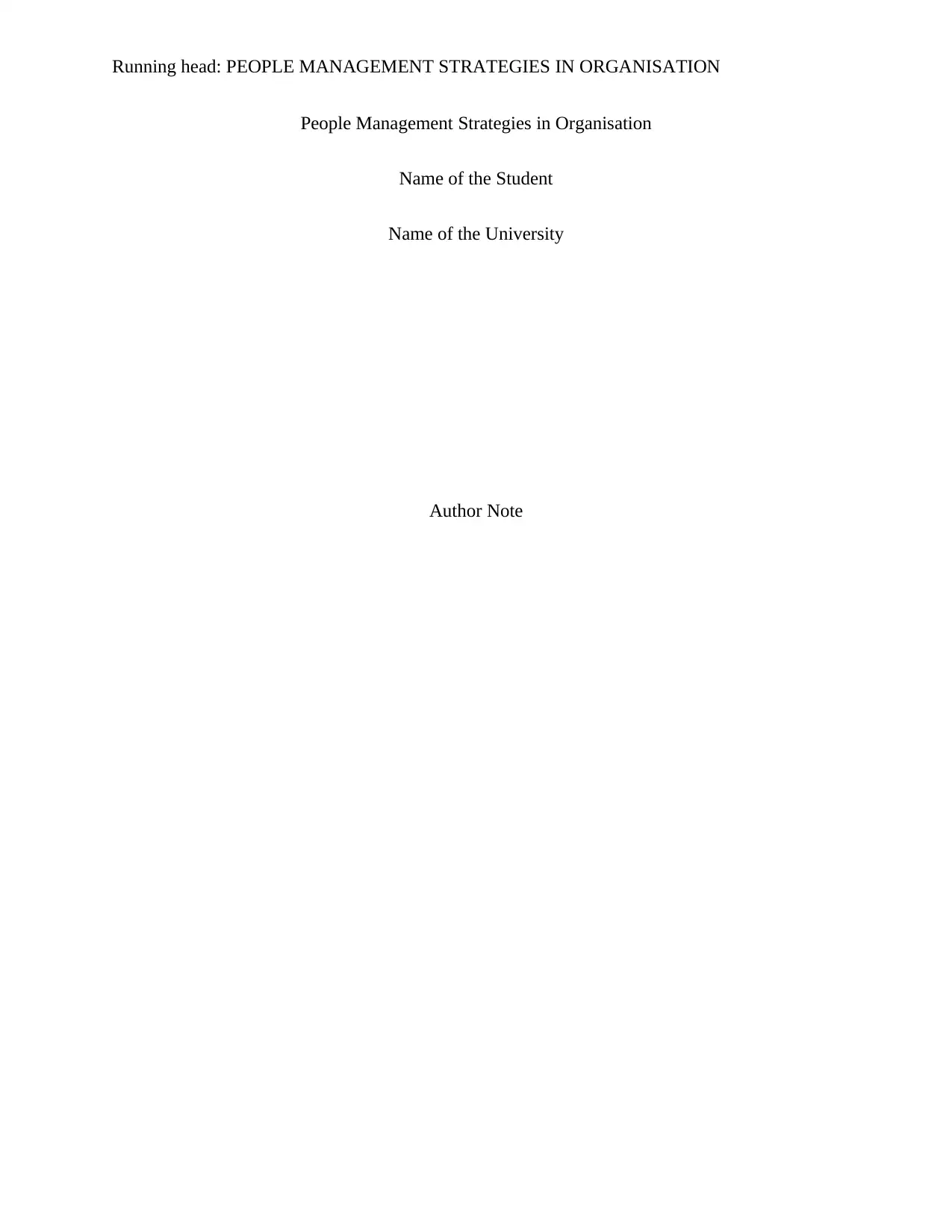
Running head: PEOPLE MANAGEMENT STRATEGIES IN ORGANISATION
People Management Strategies in Organisation
Name of the Student
Name of the University
Author Note
People Management Strategies in Organisation
Name of the Student
Name of the University
Author Note
Paraphrase This Document
Need a fresh take? Get an instant paraphrase of this document with our AI Paraphraser
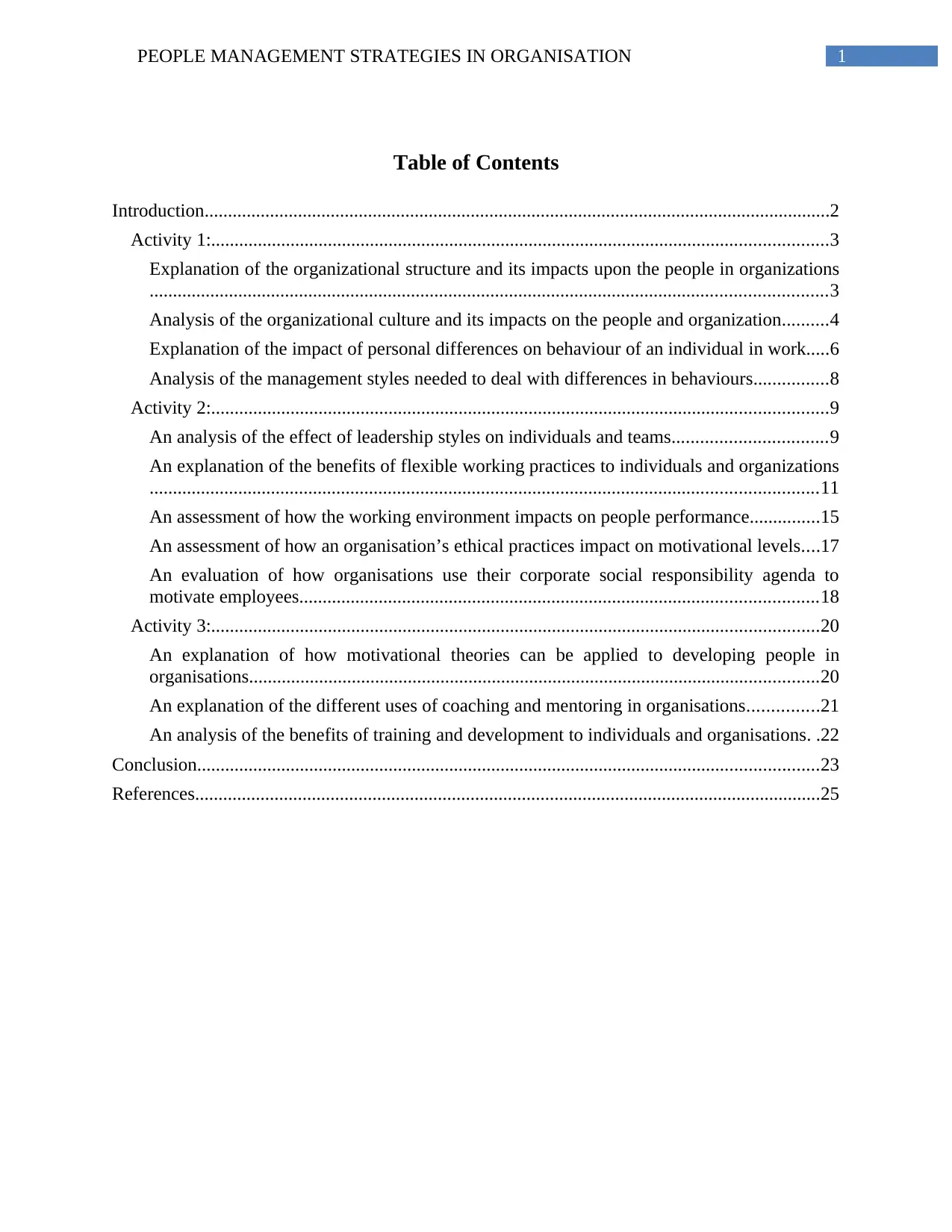
1PEOPLE MANAGEMENT STRATEGIES IN ORGANISATION
Table of Contents
Introduction......................................................................................................................................2
Activity 1:....................................................................................................................................3
Explanation of the organizational structure and its impacts upon the people in organizations
.................................................................................................................................................3
Analysis of the organizational culture and its impacts on the people and organization..........4
Explanation of the impact of personal differences on behaviour of an individual in work.....6
Analysis of the management styles needed to deal with differences in behaviours................8
Activity 2:....................................................................................................................................9
An analysis of the effect of leadership styles on individuals and teams.................................9
An explanation of the benefits of flexible working practices to individuals and organizations
...............................................................................................................................................11
An assessment of how the working environment impacts on people performance...............15
An assessment of how an organisation’s ethical practices impact on motivational levels....17
An evaluation of how organisations use their corporate social responsibility agenda to
motivate employees...............................................................................................................18
Activity 3:..................................................................................................................................20
An explanation of how motivational theories can be applied to developing people in
organisations..........................................................................................................................20
An explanation of the different uses of coaching and mentoring in organisations...............21
An analysis of the benefits of training and development to individuals and organisations. .22
Conclusion.....................................................................................................................................23
References......................................................................................................................................25
Table of Contents
Introduction......................................................................................................................................2
Activity 1:....................................................................................................................................3
Explanation of the organizational structure and its impacts upon the people in organizations
.................................................................................................................................................3
Analysis of the organizational culture and its impacts on the people and organization..........4
Explanation of the impact of personal differences on behaviour of an individual in work.....6
Analysis of the management styles needed to deal with differences in behaviours................8
Activity 2:....................................................................................................................................9
An analysis of the effect of leadership styles on individuals and teams.................................9
An explanation of the benefits of flexible working practices to individuals and organizations
...............................................................................................................................................11
An assessment of how the working environment impacts on people performance...............15
An assessment of how an organisation’s ethical practices impact on motivational levels....17
An evaluation of how organisations use their corporate social responsibility agenda to
motivate employees...............................................................................................................18
Activity 3:..................................................................................................................................20
An explanation of how motivational theories can be applied to developing people in
organisations..........................................................................................................................20
An explanation of the different uses of coaching and mentoring in organisations...............21
An analysis of the benefits of training and development to individuals and organisations. .22
Conclusion.....................................................................................................................................23
References......................................................................................................................................25
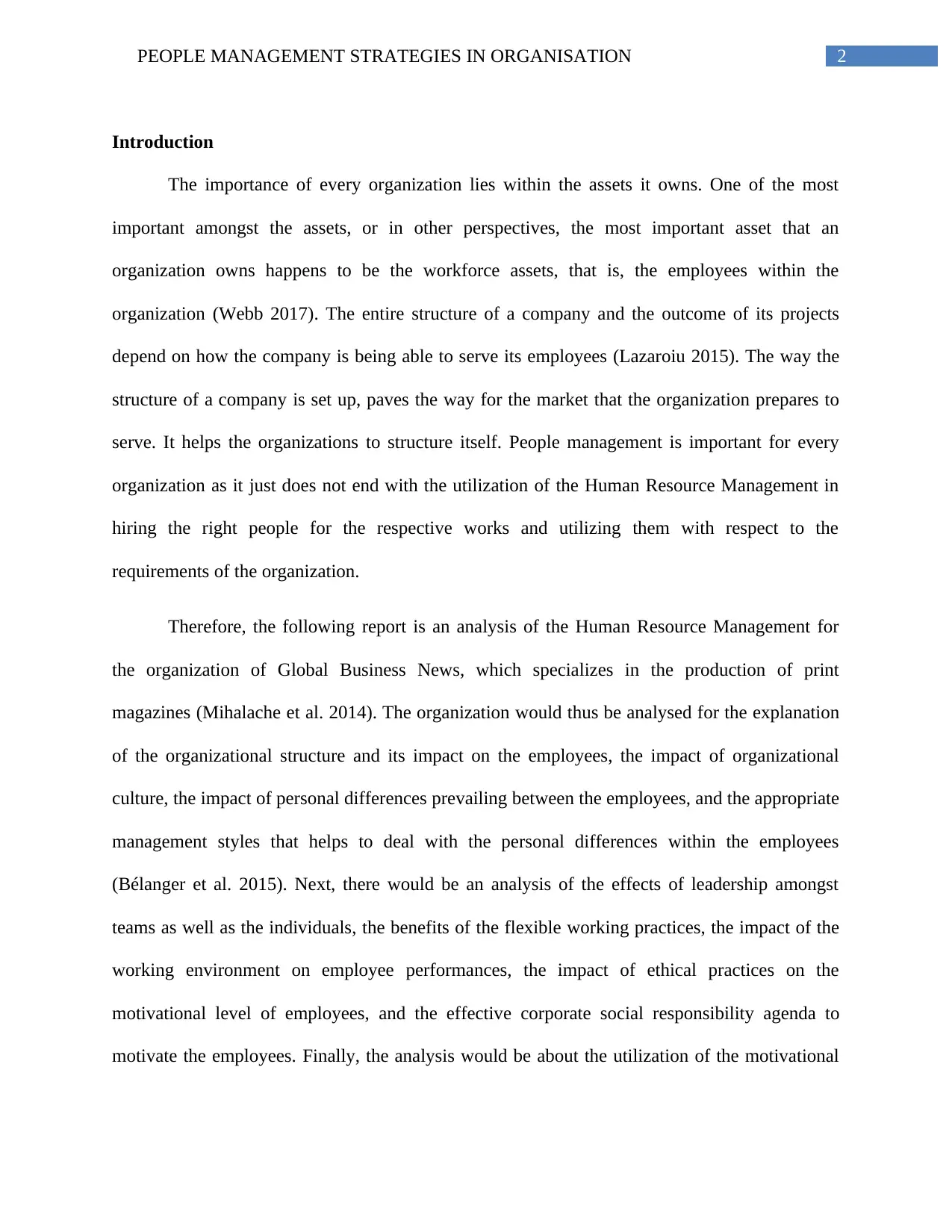
2PEOPLE MANAGEMENT STRATEGIES IN ORGANISATION
Introduction
The importance of every organization lies within the assets it owns. One of the most
important amongst the assets, or in other perspectives, the most important asset that an
organization owns happens to be the workforce assets, that is, the employees within the
organization (Webb 2017). The entire structure of a company and the outcome of its projects
depend on how the company is being able to serve its employees (Lazaroiu 2015). The way the
structure of a company is set up, paves the way for the market that the organization prepares to
serve. It helps the organizations to structure itself. People management is important for every
organization as it just does not end with the utilization of the Human Resource Management in
hiring the right people for the respective works and utilizing them with respect to the
requirements of the organization.
Therefore, the following report is an analysis of the Human Resource Management for
the organization of Global Business News, which specializes in the production of print
magazines (Mihalache et al. 2014). The organization would thus be analysed for the explanation
of the organizational structure and its impact on the employees, the impact of organizational
culture, the impact of personal differences prevailing between the employees, and the appropriate
management styles that helps to deal with the personal differences within the employees
(Bélanger et al. 2015). Next, there would be an analysis of the effects of leadership amongst
teams as well as the individuals, the benefits of the flexible working practices, the impact of the
working environment on employee performances, the impact of ethical practices on the
motivational level of employees, and the effective corporate social responsibility agenda to
motivate the employees. Finally, the analysis would be about the utilization of the motivational
Introduction
The importance of every organization lies within the assets it owns. One of the most
important amongst the assets, or in other perspectives, the most important asset that an
organization owns happens to be the workforce assets, that is, the employees within the
organization (Webb 2017). The entire structure of a company and the outcome of its projects
depend on how the company is being able to serve its employees (Lazaroiu 2015). The way the
structure of a company is set up, paves the way for the market that the organization prepares to
serve. It helps the organizations to structure itself. People management is important for every
organization as it just does not end with the utilization of the Human Resource Management in
hiring the right people for the respective works and utilizing them with respect to the
requirements of the organization.
Therefore, the following report is an analysis of the Human Resource Management for
the organization of Global Business News, which specializes in the production of print
magazines (Mihalache et al. 2014). The organization would thus be analysed for the explanation
of the organizational structure and its impact on the employees, the impact of organizational
culture, the impact of personal differences prevailing between the employees, and the appropriate
management styles that helps to deal with the personal differences within the employees
(Bélanger et al. 2015). Next, there would be an analysis of the effects of leadership amongst
teams as well as the individuals, the benefits of the flexible working practices, the impact of the
working environment on employee performances, the impact of ethical practices on the
motivational level of employees, and the effective corporate social responsibility agenda to
motivate the employees. Finally, the analysis would be about the utilization of the motivational
⊘ This is a preview!⊘
Do you want full access?
Subscribe today to unlock all pages.

Trusted by 1+ million students worldwide
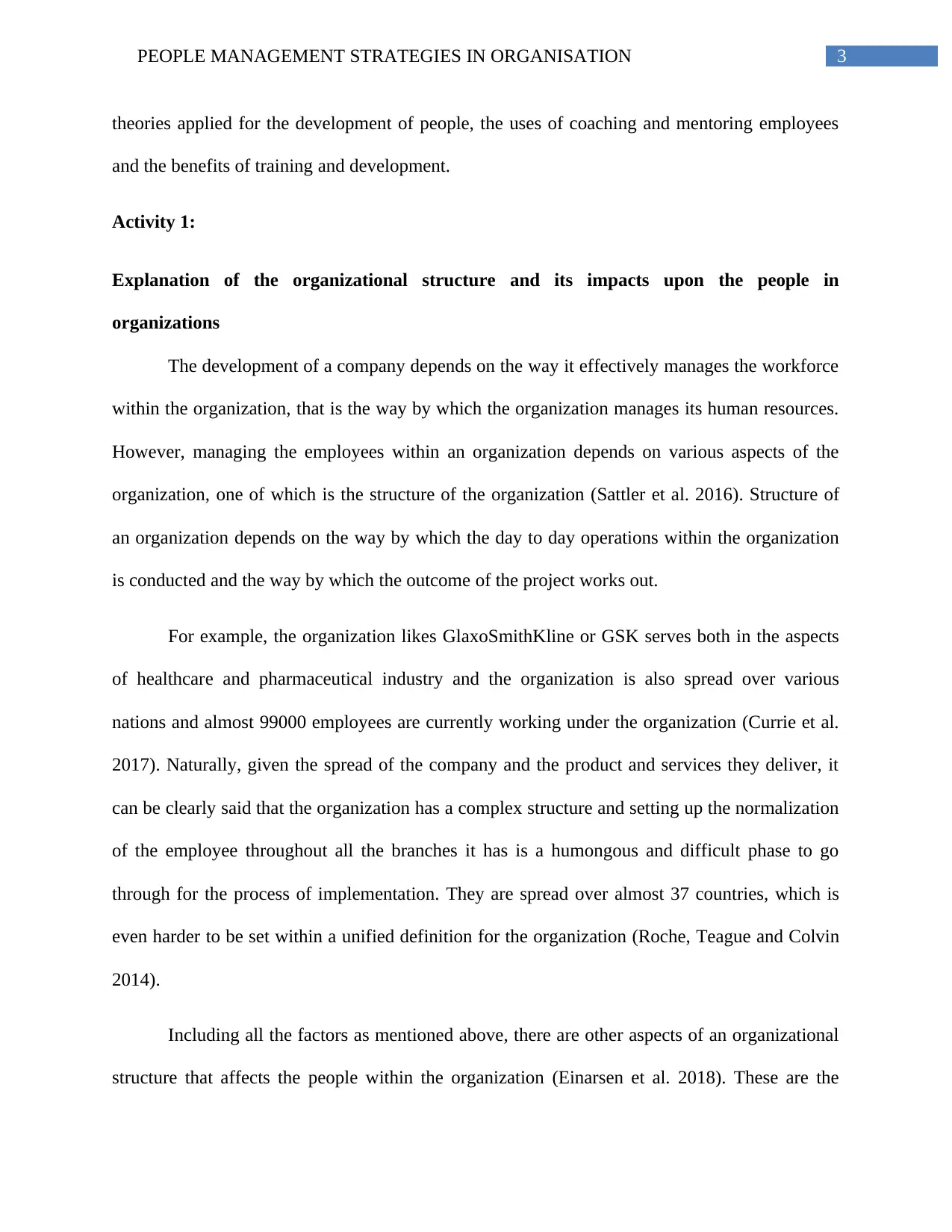
3PEOPLE MANAGEMENT STRATEGIES IN ORGANISATION
theories applied for the development of people, the uses of coaching and mentoring employees
and the benefits of training and development.
Activity 1:
Explanation of the organizational structure and its impacts upon the people in
organizations
The development of a company depends on the way it effectively manages the workforce
within the organization, that is the way by which the organization manages its human resources.
However, managing the employees within an organization depends on various aspects of the
organization, one of which is the structure of the organization (Sattler et al. 2016). Structure of
an organization depends on the way by which the day to day operations within the organization
is conducted and the way by which the outcome of the project works out.
For example, the organization likes GlaxoSmithKline or GSK serves both in the aspects
of healthcare and pharmaceutical industry and the organization is also spread over various
nations and almost 99000 employees are currently working under the organization (Currie et al.
2017). Naturally, given the spread of the company and the product and services they deliver, it
can be clearly said that the organization has a complex structure and setting up the normalization
of the employee throughout all the branches it has is a humongous and difficult phase to go
through for the process of implementation. They are spread over almost 37 countries, which is
even harder to be set within a unified definition for the organization (Roche, Teague and Colvin
2014).
Including all the factors as mentioned above, there are other aspects of an organizational
structure that affects the people within the organization (Einarsen et al. 2018). These are the
theories applied for the development of people, the uses of coaching and mentoring employees
and the benefits of training and development.
Activity 1:
Explanation of the organizational structure and its impacts upon the people in
organizations
The development of a company depends on the way it effectively manages the workforce
within the organization, that is the way by which the organization manages its human resources.
However, managing the employees within an organization depends on various aspects of the
organization, one of which is the structure of the organization (Sattler et al. 2016). Structure of
an organization depends on the way by which the day to day operations within the organization
is conducted and the way by which the outcome of the project works out.
For example, the organization likes GlaxoSmithKline or GSK serves both in the aspects
of healthcare and pharmaceutical industry and the organization is also spread over various
nations and almost 99000 employees are currently working under the organization (Currie et al.
2017). Naturally, given the spread of the company and the product and services they deliver, it
can be clearly said that the organization has a complex structure and setting up the normalization
of the employee throughout all the branches it has is a humongous and difficult phase to go
through for the process of implementation. They are spread over almost 37 countries, which is
even harder to be set within a unified definition for the organization (Roche, Teague and Colvin
2014).
Including all the factors as mentioned above, there are other aspects of an organizational
structure that affects the people within the organization (Einarsen et al. 2018). These are the
Paraphrase This Document
Need a fresh take? Get an instant paraphrase of this document with our AI Paraphraser
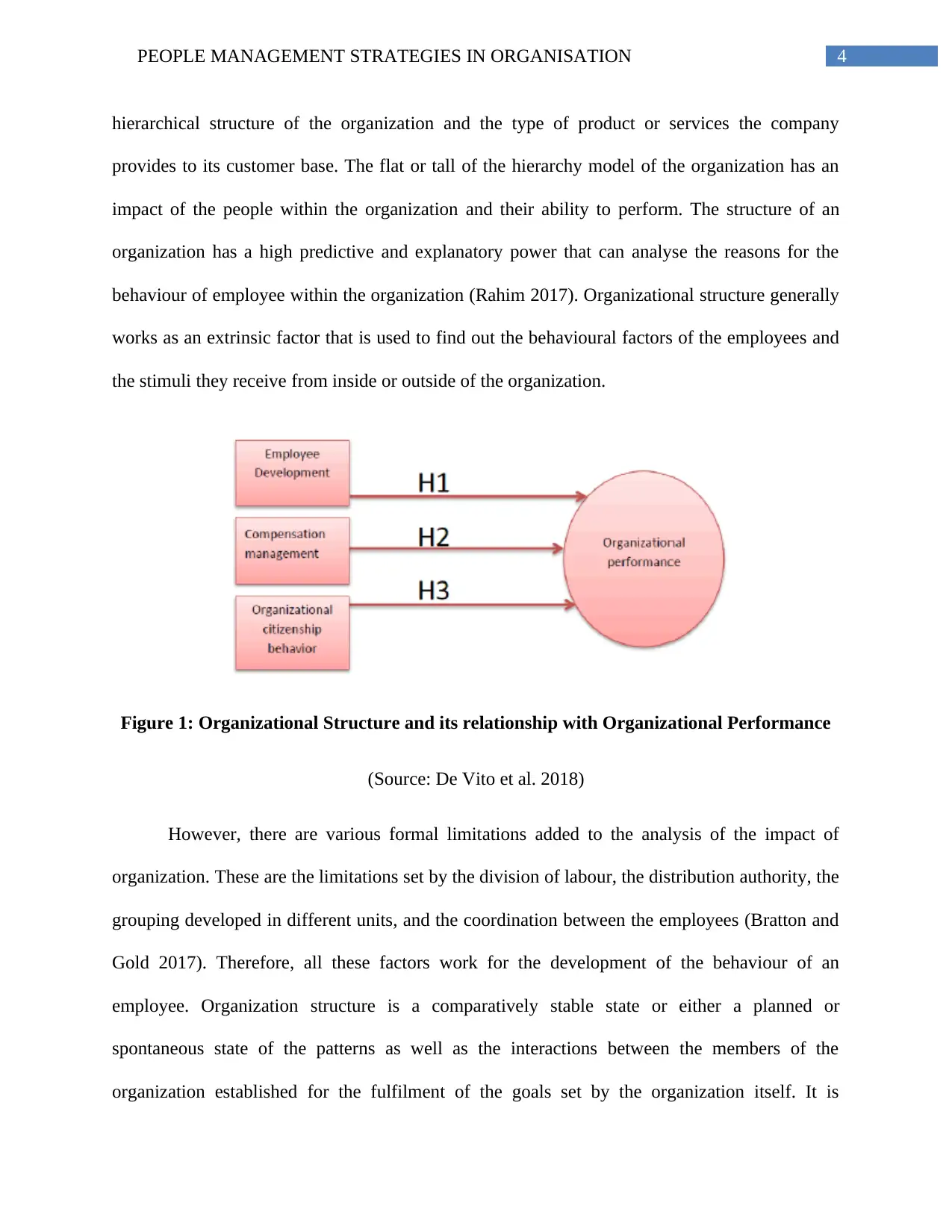
4PEOPLE MANAGEMENT STRATEGIES IN ORGANISATION
hierarchical structure of the organization and the type of product or services the company
provides to its customer base. The flat or tall of the hierarchy model of the organization has an
impact of the people within the organization and their ability to perform. The structure of an
organization has a high predictive and explanatory power that can analyse the reasons for the
behaviour of employee within the organization (Rahim 2017). Organizational structure generally
works as an extrinsic factor that is used to find out the behavioural factors of the employees and
the stimuli they receive from inside or outside of the organization.
Figure 1: Organizational Structure and its relationship with Organizational Performance
(Source: De Vito et al. 2018)
However, there are various formal limitations added to the analysis of the impact of
organization. These are the limitations set by the division of labour, the distribution authority, the
grouping developed in different units, and the coordination between the employees (Bratton and
Gold 2017). Therefore, all these factors work for the development of the behaviour of an
employee. Organization structure is a comparatively stable state or either a planned or
spontaneous state of the patterns as well as the interactions between the members of the
organization established for the fulfilment of the goals set by the organization itself. It is
hierarchical structure of the organization and the type of product or services the company
provides to its customer base. The flat or tall of the hierarchy model of the organization has an
impact of the people within the organization and their ability to perform. The structure of an
organization has a high predictive and explanatory power that can analyse the reasons for the
behaviour of employee within the organization (Rahim 2017). Organizational structure generally
works as an extrinsic factor that is used to find out the behavioural factors of the employees and
the stimuli they receive from inside or outside of the organization.
Figure 1: Organizational Structure and its relationship with Organizational Performance
(Source: De Vito et al. 2018)
However, there are various formal limitations added to the analysis of the impact of
organization. These are the limitations set by the division of labour, the distribution authority, the
grouping developed in different units, and the coordination between the employees (Bratton and
Gold 2017). Therefore, all these factors work for the development of the behaviour of an
employee. Organization structure is a comparatively stable state or either a planned or
spontaneous state of the patterns as well as the interactions between the members of the
organization established for the fulfilment of the goals set by the organization itself. It is
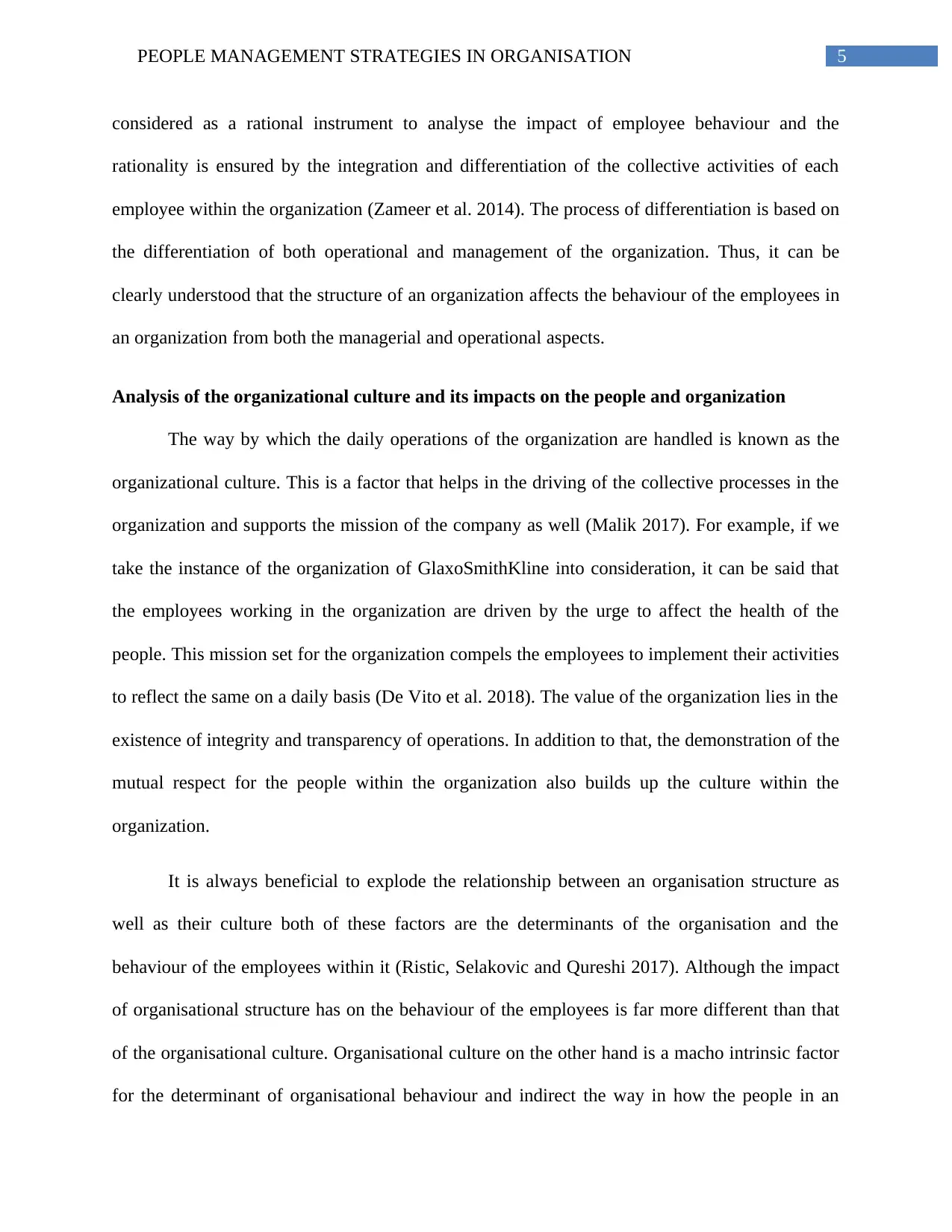
5PEOPLE MANAGEMENT STRATEGIES IN ORGANISATION
considered as a rational instrument to analyse the impact of employee behaviour and the
rationality is ensured by the integration and differentiation of the collective activities of each
employee within the organization (Zameer et al. 2014). The process of differentiation is based on
the differentiation of both operational and management of the organization. Thus, it can be
clearly understood that the structure of an organization affects the behaviour of the employees in
an organization from both the managerial and operational aspects.
Analysis of the organizational culture and its impacts on the people and organization
The way by which the daily operations of the organization are handled is known as the
organizational culture. This is a factor that helps in the driving of the collective processes in the
organization and supports the mission of the company as well (Malik 2017). For example, if we
take the instance of the organization of GlaxoSmithKline into consideration, it can be said that
the employees working in the organization are driven by the urge to affect the health of the
people. This mission set for the organization compels the employees to implement their activities
to reflect the same on a daily basis (De Vito et al. 2018). The value of the organization lies in the
existence of integrity and transparency of operations. In addition to that, the demonstration of the
mutual respect for the people within the organization also builds up the culture within the
organization.
It is always beneficial to explode the relationship between an organisation structure as
well as their culture both of these factors are the determinants of the organisation and the
behaviour of the employees within it (Ristic, Selakovic and Qureshi 2017). Although the impact
of organisational structure has on the behaviour of the employees is far more different than that
of the organisational culture. Organisational culture on the other hand is a macho intrinsic factor
for the determinant of organisational behaviour and indirect the way in how the people in an
considered as a rational instrument to analyse the impact of employee behaviour and the
rationality is ensured by the integration and differentiation of the collective activities of each
employee within the organization (Zameer et al. 2014). The process of differentiation is based on
the differentiation of both operational and management of the organization. Thus, it can be
clearly understood that the structure of an organization affects the behaviour of the employees in
an organization from both the managerial and operational aspects.
Analysis of the organizational culture and its impacts on the people and organization
The way by which the daily operations of the organization are handled is known as the
organizational culture. This is a factor that helps in the driving of the collective processes in the
organization and supports the mission of the company as well (Malik 2017). For example, if we
take the instance of the organization of GlaxoSmithKline into consideration, it can be said that
the employees working in the organization are driven by the urge to affect the health of the
people. This mission set for the organization compels the employees to implement their activities
to reflect the same on a daily basis (De Vito et al. 2018). The value of the organization lies in the
existence of integrity and transparency of operations. In addition to that, the demonstration of the
mutual respect for the people within the organization also builds up the culture within the
organization.
It is always beneficial to explode the relationship between an organisation structure as
well as their culture both of these factors are the determinants of the organisation and the
behaviour of the employees within it (Ristic, Selakovic and Qureshi 2017). Although the impact
of organisational structure has on the behaviour of the employees is far more different than that
of the organisational culture. Organisational culture on the other hand is a macho intrinsic factor
for the determinant of organisational behaviour and indirect the way in how the people in an
⊘ This is a preview!⊘
Do you want full access?
Subscribe today to unlock all pages.

Trusted by 1+ million students worldwide
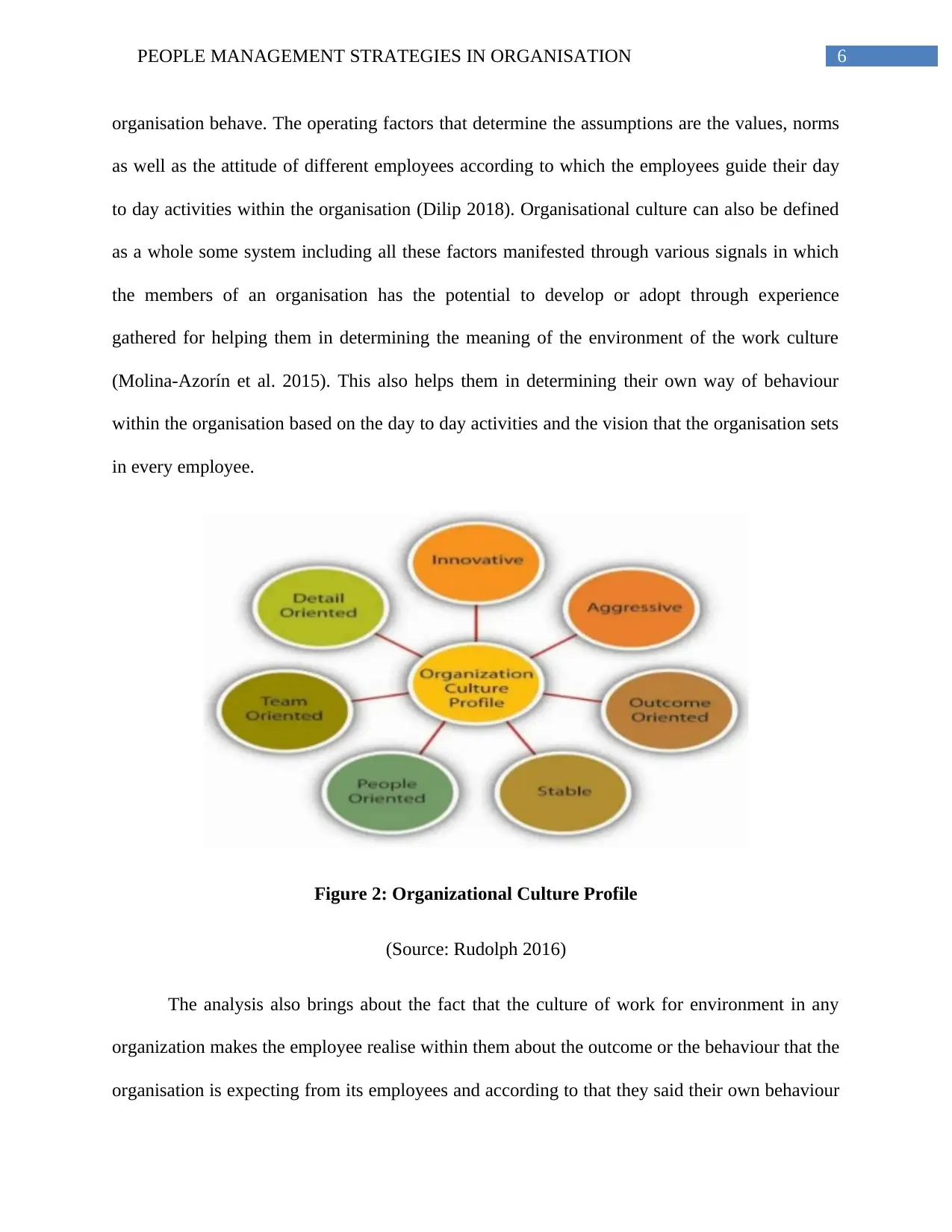
6PEOPLE MANAGEMENT STRATEGIES IN ORGANISATION
organisation behave. The operating factors that determine the assumptions are the values, norms
as well as the attitude of different employees according to which the employees guide their day
to day activities within the organisation (Dilip 2018). Organisational culture can also be defined
as a whole some system including all these factors manifested through various signals in which
the members of an organisation has the potential to develop or adopt through experience
gathered for helping them in determining the meaning of the environment of the work culture
(Molina-Azorín et al. 2015). This also helps them in determining their own way of behaviour
within the organisation based on the day to day activities and the vision that the organisation sets
in every employee.
Figure 2: Organizational Culture Profile
(Source: Rudolph 2016)
The analysis also brings about the fact that the culture of work for environment in any
organization makes the employee realise within them about the outcome or the behaviour that the
organisation is expecting from its employees and according to that they said their own behaviour
organisation behave. The operating factors that determine the assumptions are the values, norms
as well as the attitude of different employees according to which the employees guide their day
to day activities within the organisation (Dilip 2018). Organisational culture can also be defined
as a whole some system including all these factors manifested through various signals in which
the members of an organisation has the potential to develop or adopt through experience
gathered for helping them in determining the meaning of the environment of the work culture
(Molina-Azorín et al. 2015). This also helps them in determining their own way of behaviour
within the organisation based on the day to day activities and the vision that the organisation sets
in every employee.
Figure 2: Organizational Culture Profile
(Source: Rudolph 2016)
The analysis also brings about the fact that the culture of work for environment in any
organization makes the employee realise within them about the outcome or the behaviour that the
organisation is expecting from its employees and according to that they said their own behaviour
Paraphrase This Document
Need a fresh take? Get an instant paraphrase of this document with our AI Paraphraser
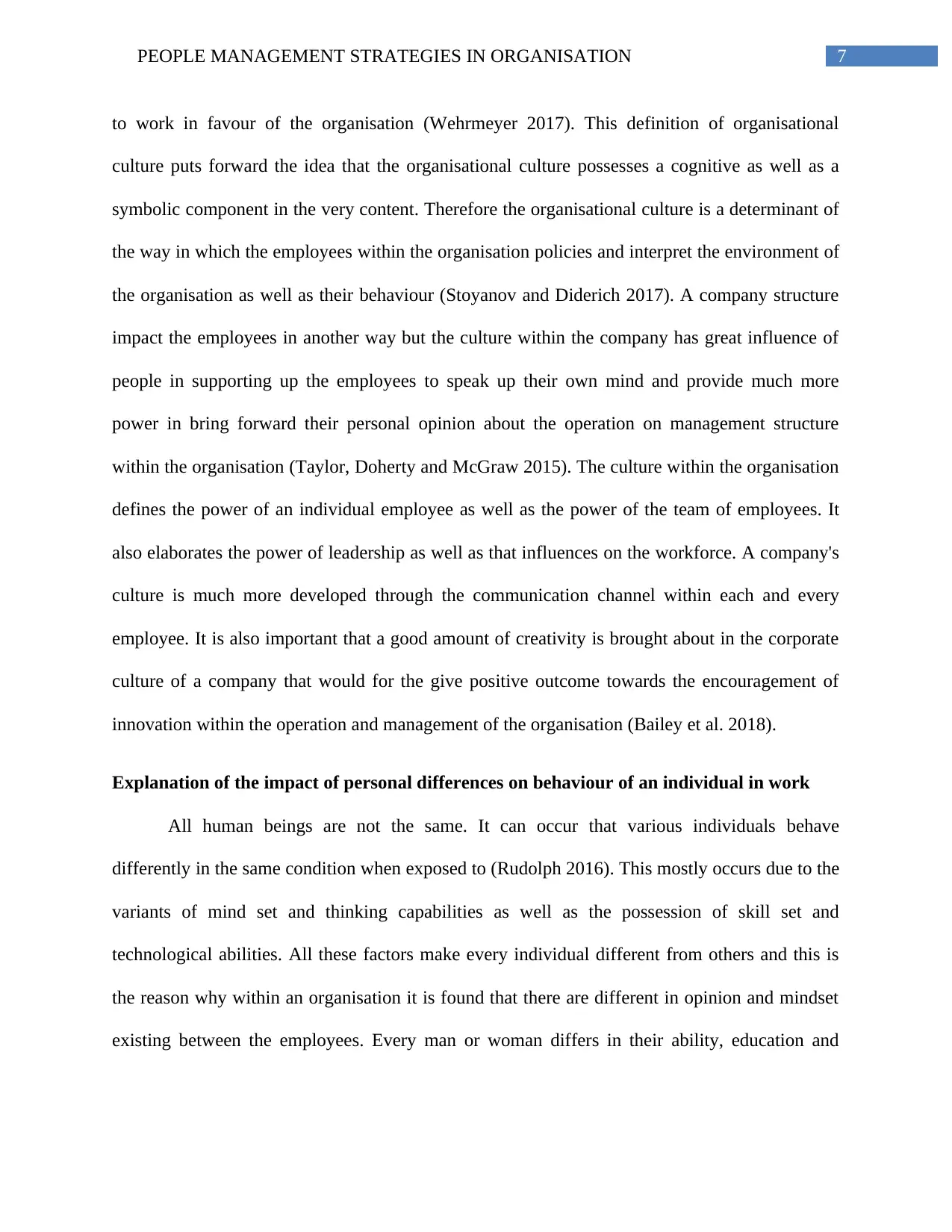
7PEOPLE MANAGEMENT STRATEGIES IN ORGANISATION
to work in favour of the organisation (Wehrmeyer 2017). This definition of organisational
culture puts forward the idea that the organisational culture possesses a cognitive as well as a
symbolic component in the very content. Therefore the organisational culture is a determinant of
the way in which the employees within the organisation policies and interpret the environment of
the organisation as well as their behaviour (Stoyanov and Diderich 2017). A company structure
impact the employees in another way but the culture within the company has great influence of
people in supporting up the employees to speak up their own mind and provide much more
power in bring forward their personal opinion about the operation on management structure
within the organisation (Taylor, Doherty and McGraw 2015). The culture within the organisation
defines the power of an individual employee as well as the power of the team of employees. It
also elaborates the power of leadership as well as that influences on the workforce. A company's
culture is much more developed through the communication channel within each and every
employee. It is also important that a good amount of creativity is brought about in the corporate
culture of a company that would for the give positive outcome towards the encouragement of
innovation within the operation and management of the organisation (Bailey et al. 2018).
Explanation of the impact of personal differences on behaviour of an individual in work
All human beings are not the same. It can occur that various individuals behave
differently in the same condition when exposed to (Rudolph 2016). This mostly occurs due to the
variants of mind set and thinking capabilities as well as the possession of skill set and
technological abilities. All these factors make every individual different from others and this is
the reason why within an organisation it is found that there are different in opinion and mindset
existing between the employees. Every man or woman differs in their ability, education and
to work in favour of the organisation (Wehrmeyer 2017). This definition of organisational
culture puts forward the idea that the organisational culture possesses a cognitive as well as a
symbolic component in the very content. Therefore the organisational culture is a determinant of
the way in which the employees within the organisation policies and interpret the environment of
the organisation as well as their behaviour (Stoyanov and Diderich 2017). A company structure
impact the employees in another way but the culture within the company has great influence of
people in supporting up the employees to speak up their own mind and provide much more
power in bring forward their personal opinion about the operation on management structure
within the organisation (Taylor, Doherty and McGraw 2015). The culture within the organisation
defines the power of an individual employee as well as the power of the team of employees. It
also elaborates the power of leadership as well as that influences on the workforce. A company's
culture is much more developed through the communication channel within each and every
employee. It is also important that a good amount of creativity is brought about in the corporate
culture of a company that would for the give positive outcome towards the encouragement of
innovation within the operation and management of the organisation (Bailey et al. 2018).
Explanation of the impact of personal differences on behaviour of an individual in work
All human beings are not the same. It can occur that various individuals behave
differently in the same condition when exposed to (Rudolph 2016). This mostly occurs due to the
variants of mind set and thinking capabilities as well as the possession of skill set and
technological abilities. All these factors make every individual different from others and this is
the reason why within an organisation it is found that there are different in opinion and mindset
existing between the employees. Every man or woman differs in their ability, education and
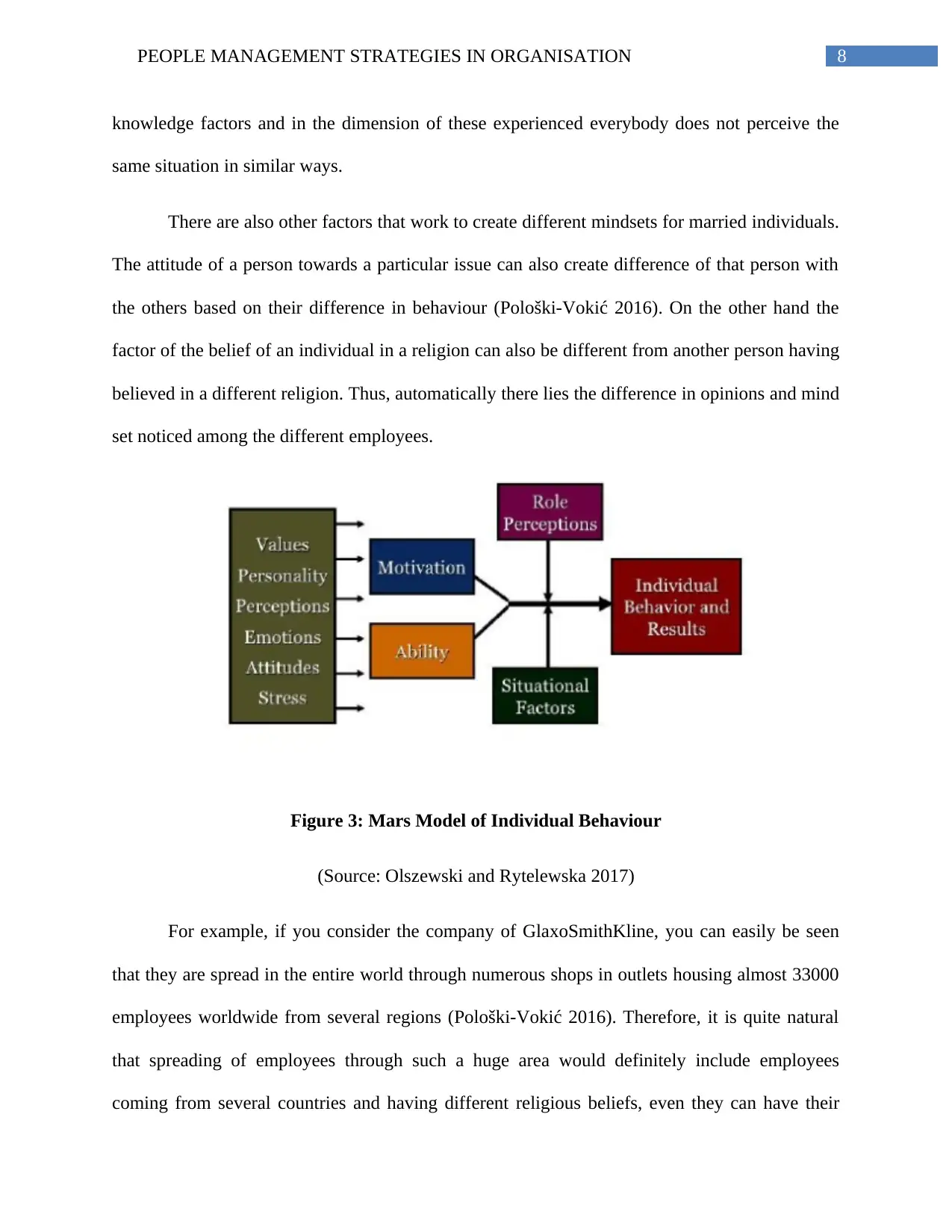
8PEOPLE MANAGEMENT STRATEGIES IN ORGANISATION
knowledge factors and in the dimension of these experienced everybody does not perceive the
same situation in similar ways.
There are also other factors that work to create different mindsets for married individuals.
The attitude of a person towards a particular issue can also create difference of that person with
the others based on their difference in behaviour (Pološki-Vokić 2016). On the other hand the
factor of the belief of an individual in a religion can also be different from another person having
believed in a different religion. Thus, automatically there lies the difference in opinions and mind
set noticed among the different employees.
Figure 3: Mars Model of Individual Behaviour
(Source: Olszewski and Rytelewska 2017)
For example, if you consider the company of GlaxoSmithKline, you can easily be seen
that they are spread in the entire world through numerous shops in outlets housing almost 33000
employees worldwide from several regions (Pološki-Vokić 2016). Therefore, it is quite natural
that spreading of employees through such a huge area would definitely include employees
coming from several countries and having different religious beliefs, even they can have their
knowledge factors and in the dimension of these experienced everybody does not perceive the
same situation in similar ways.
There are also other factors that work to create different mindsets for married individuals.
The attitude of a person towards a particular issue can also create difference of that person with
the others based on their difference in behaviour (Pološki-Vokić 2016). On the other hand the
factor of the belief of an individual in a religion can also be different from another person having
believed in a different religion. Thus, automatically there lies the difference in opinions and mind
set noticed among the different employees.
Figure 3: Mars Model of Individual Behaviour
(Source: Olszewski and Rytelewska 2017)
For example, if you consider the company of GlaxoSmithKline, you can easily be seen
that they are spread in the entire world through numerous shops in outlets housing almost 33000
employees worldwide from several regions (Pološki-Vokić 2016). Therefore, it is quite natural
that spreading of employees through such a huge area would definitely include employees
coming from several countries and having different religious beliefs, even they can have their
⊘ This is a preview!⊘
Do you want full access?
Subscribe today to unlock all pages.

Trusted by 1+ million students worldwide
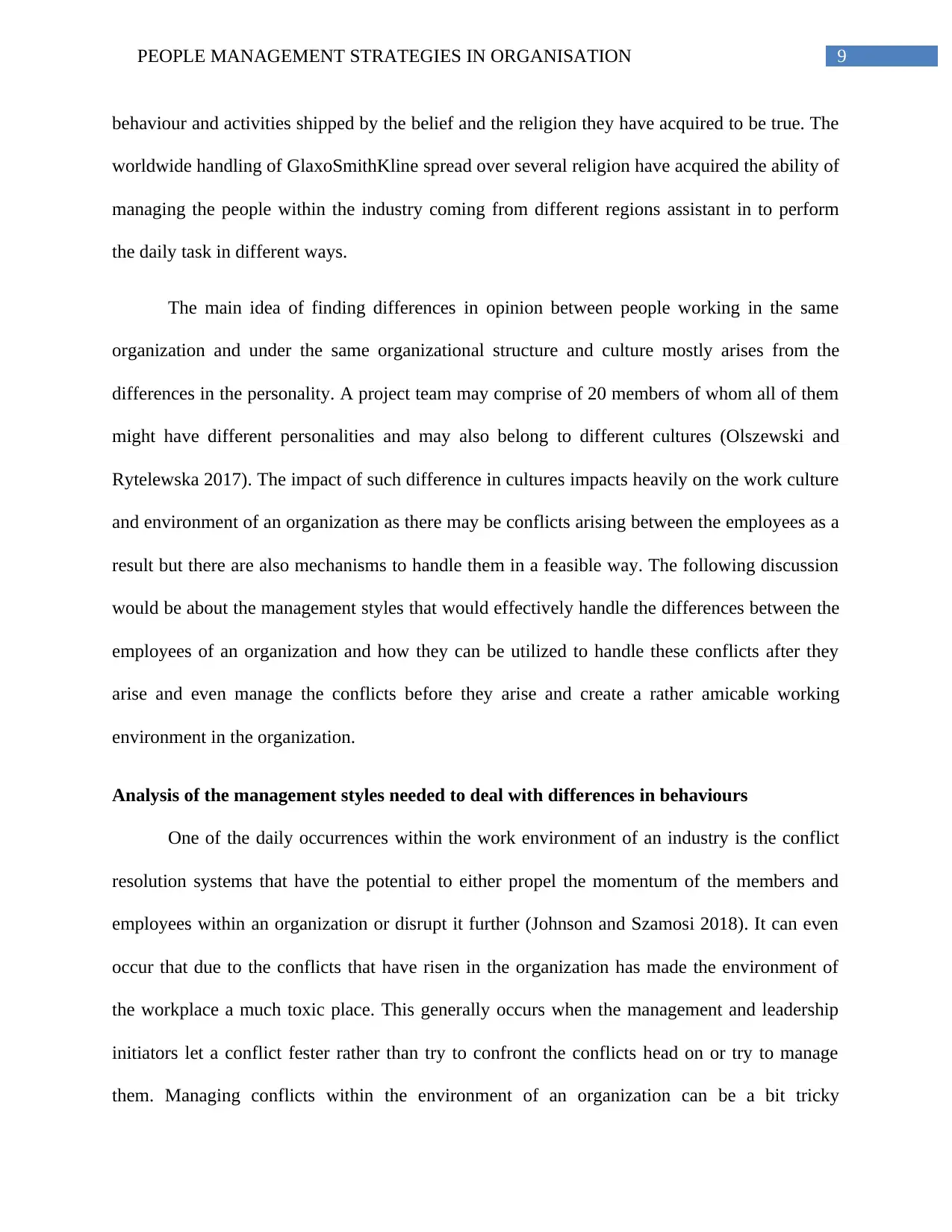
9PEOPLE MANAGEMENT STRATEGIES IN ORGANISATION
behaviour and activities shipped by the belief and the religion they have acquired to be true. The
worldwide handling of GlaxoSmithKline spread over several religion have acquired the ability of
managing the people within the industry coming from different regions assistant in to perform
the daily task in different ways.
The main idea of finding differences in opinion between people working in the same
organization and under the same organizational structure and culture mostly arises from the
differences in the personality. A project team may comprise of 20 members of whom all of them
might have different personalities and may also belong to different cultures (Olszewski and
Rytelewska 2017). The impact of such difference in cultures impacts heavily on the work culture
and environment of an organization as there may be conflicts arising between the employees as a
result but there are also mechanisms to handle them in a feasible way. The following discussion
would be about the management styles that would effectively handle the differences between the
employees of an organization and how they can be utilized to handle these conflicts after they
arise and even manage the conflicts before they arise and create a rather amicable working
environment in the organization.
Analysis of the management styles needed to deal with differences in behaviours
One of the daily occurrences within the work environment of an industry is the conflict
resolution systems that have the potential to either propel the momentum of the members and
employees within an organization or disrupt it further (Johnson and Szamosi 2018). It can even
occur that due to the conflicts that have risen in the organization has made the environment of
the workplace a much toxic place. This generally occurs when the management and leadership
initiators let a conflict fester rather than try to confront the conflicts head on or try to manage
them. Managing conflicts within the environment of an organization can be a bit tricky
behaviour and activities shipped by the belief and the religion they have acquired to be true. The
worldwide handling of GlaxoSmithKline spread over several religion have acquired the ability of
managing the people within the industry coming from different regions assistant in to perform
the daily task in different ways.
The main idea of finding differences in opinion between people working in the same
organization and under the same organizational structure and culture mostly arises from the
differences in the personality. A project team may comprise of 20 members of whom all of them
might have different personalities and may also belong to different cultures (Olszewski and
Rytelewska 2017). The impact of such difference in cultures impacts heavily on the work culture
and environment of an organization as there may be conflicts arising between the employees as a
result but there are also mechanisms to handle them in a feasible way. The following discussion
would be about the management styles that would effectively handle the differences between the
employees of an organization and how they can be utilized to handle these conflicts after they
arise and even manage the conflicts before they arise and create a rather amicable working
environment in the organization.
Analysis of the management styles needed to deal with differences in behaviours
One of the daily occurrences within the work environment of an industry is the conflict
resolution systems that have the potential to either propel the momentum of the members and
employees within an organization or disrupt it further (Johnson and Szamosi 2018). It can even
occur that due to the conflicts that have risen in the organization has made the environment of
the workplace a much toxic place. This generally occurs when the management and leadership
initiators let a conflict fester rather than try to confront the conflicts head on or try to manage
them. Managing conflicts within the environment of an organization can be a bit tricky
Paraphrase This Document
Need a fresh take? Get an instant paraphrase of this document with our AI Paraphraser
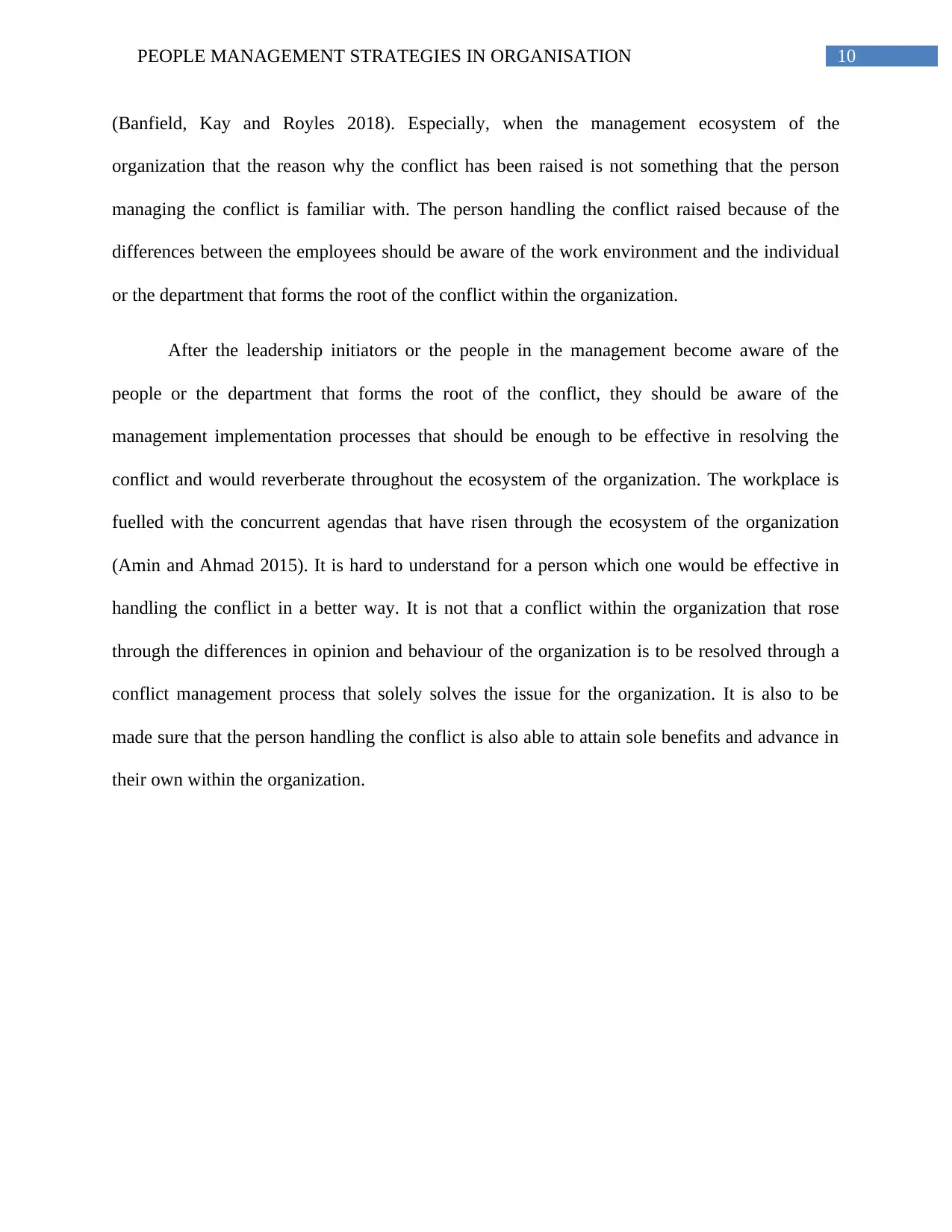
10PEOPLE MANAGEMENT STRATEGIES IN ORGANISATION
(Banfield, Kay and Royles 2018). Especially, when the management ecosystem of the
organization that the reason why the conflict has been raised is not something that the person
managing the conflict is familiar with. The person handling the conflict raised because of the
differences between the employees should be aware of the work environment and the individual
or the department that forms the root of the conflict within the organization.
After the leadership initiators or the people in the management become aware of the
people or the department that forms the root of the conflict, they should be aware of the
management implementation processes that should be enough to be effective in resolving the
conflict and would reverberate throughout the ecosystem of the organization. The workplace is
fuelled with the concurrent agendas that have risen through the ecosystem of the organization
(Amin and Ahmad 2015). It is hard to understand for a person which one would be effective in
handling the conflict in a better way. It is not that a conflict within the organization that rose
through the differences in opinion and behaviour of the organization is to be resolved through a
conflict management process that solely solves the issue for the organization. It is also to be
made sure that the person handling the conflict is also able to attain sole benefits and advance in
their own within the organization.
(Banfield, Kay and Royles 2018). Especially, when the management ecosystem of the
organization that the reason why the conflict has been raised is not something that the person
managing the conflict is familiar with. The person handling the conflict raised because of the
differences between the employees should be aware of the work environment and the individual
or the department that forms the root of the conflict within the organization.
After the leadership initiators or the people in the management become aware of the
people or the department that forms the root of the conflict, they should be aware of the
management implementation processes that should be enough to be effective in resolving the
conflict and would reverberate throughout the ecosystem of the organization. The workplace is
fuelled with the concurrent agendas that have risen through the ecosystem of the organization
(Amin and Ahmad 2015). It is hard to understand for a person which one would be effective in
handling the conflict in a better way. It is not that a conflict within the organization that rose
through the differences in opinion and behaviour of the organization is to be resolved through a
conflict management process that solely solves the issue for the organization. It is also to be
made sure that the person handling the conflict is also able to attain sole benefits and advance in
their own within the organization.
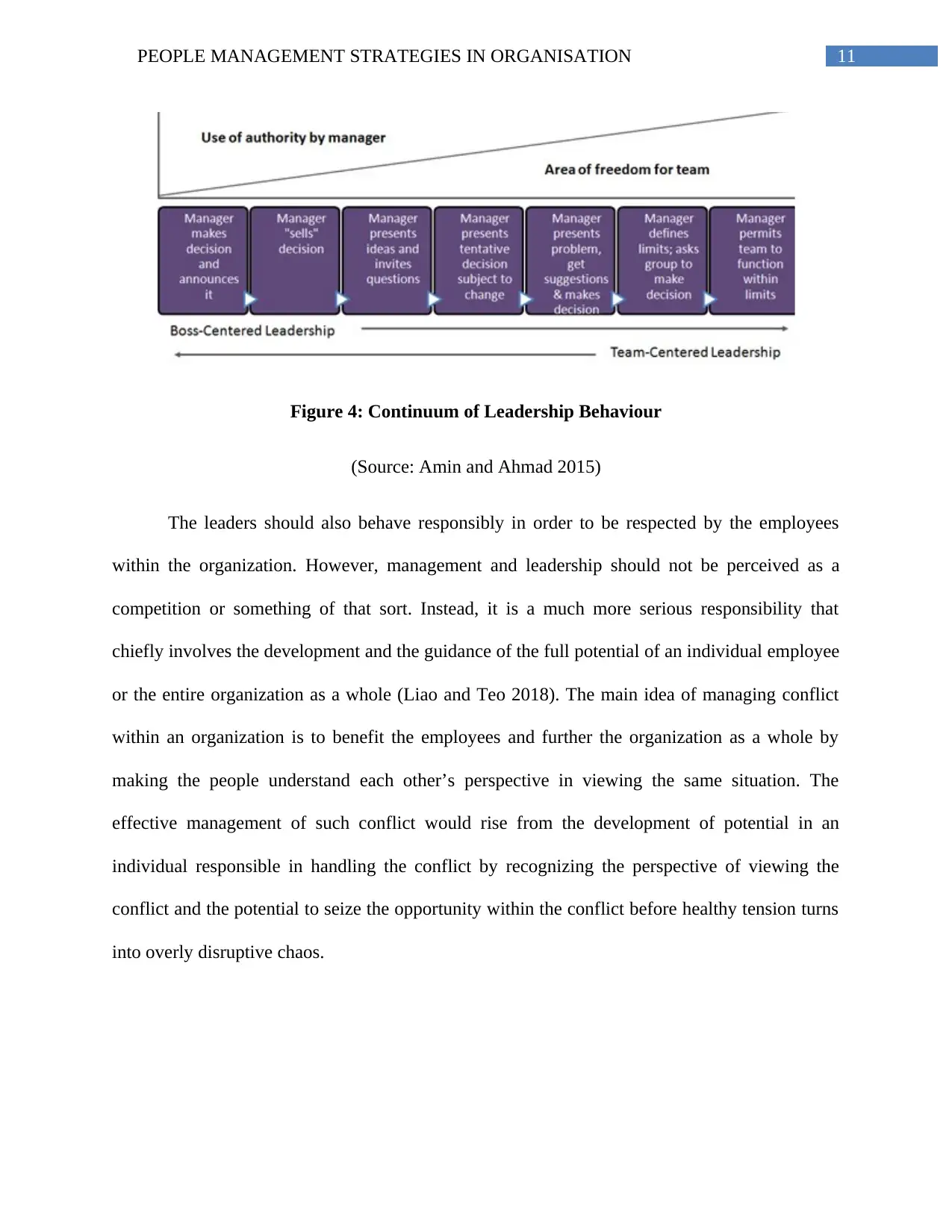
11PEOPLE MANAGEMENT STRATEGIES IN ORGANISATION
Figure 4: Continuum of Leadership Behaviour
(Source: Amin and Ahmad 2015)
The leaders should also behave responsibly in order to be respected by the employees
within the organization. However, management and leadership should not be perceived as a
competition or something of that sort. Instead, it is a much more serious responsibility that
chiefly involves the development and the guidance of the full potential of an individual employee
or the entire organization as a whole (Liao and Teo 2018). The main idea of managing conflict
within an organization is to benefit the employees and further the organization as a whole by
making the people understand each other’s perspective in viewing the same situation. The
effective management of such conflict would rise from the development of potential in an
individual responsible in handling the conflict by recognizing the perspective of viewing the
conflict and the potential to seize the opportunity within the conflict before healthy tension turns
into overly disruptive chaos.
Figure 4: Continuum of Leadership Behaviour
(Source: Amin and Ahmad 2015)
The leaders should also behave responsibly in order to be respected by the employees
within the organization. However, management and leadership should not be perceived as a
competition or something of that sort. Instead, it is a much more serious responsibility that
chiefly involves the development and the guidance of the full potential of an individual employee
or the entire organization as a whole (Liao and Teo 2018). The main idea of managing conflict
within an organization is to benefit the employees and further the organization as a whole by
making the people understand each other’s perspective in viewing the same situation. The
effective management of such conflict would rise from the development of potential in an
individual responsible in handling the conflict by recognizing the perspective of viewing the
conflict and the potential to seize the opportunity within the conflict before healthy tension turns
into overly disruptive chaos.
⊘ This is a preview!⊘
Do you want full access?
Subscribe today to unlock all pages.

Trusted by 1+ million students worldwide
1 out of 37
Related Documents
Your All-in-One AI-Powered Toolkit for Academic Success.
+13062052269
info@desklib.com
Available 24*7 on WhatsApp / Email
![[object Object]](/_next/static/media/star-bottom.7253800d.svg)
Unlock your academic potential
Copyright © 2020–2025 A2Z Services. All Rights Reserved. Developed and managed by ZUCOL.





